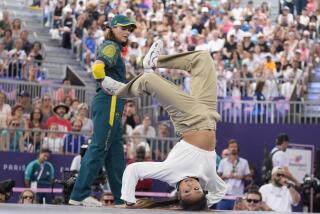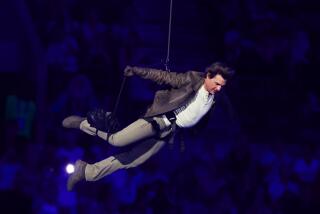Every four years, a brush with fame
Reporting from Vancouver, Canada — The appeal of curling seems obvious to Jim Smoltz as he heads toward his seat, beverages in hand, for the morning games at the Vancouver Olympic Centre.
“Beers and Bloody Marys for everyone,” he says. “It’s very social.”
Or maybe another American fan, Stacy Banack, knows the secret: All those cowbells jangling in the crowd.
“You’ve got to have the cowbell,” she says.
Whatever the reason, this quirky sport has once again become a cult favorite at the 2010 Vancouver Olympics, a hit with millions of U.S. fans who wouldn’t know a biter from a bonspiel.
Not that rocks and brooms are leading the nightly broadcast, but curling ranked fourth in page views on nbcolympics.com -- ahead of hockey -- and has delivered the best early-evening numbers that CNBC has seen in eight years.
This overnight popularity has bestowed sex-symbol status on Cheryl Bernard of the Canadian women’s team and Chris Plys, the bandanna-wearing, double-earringed American who was named “Olympic Stud of the Day” by Entertainment Weekly.
“I kind of like that,” said Plys, whose Twitter following has jumped from several hundred to more than 4,000. “People tell me they love watching it on TV.”
What’s not to like about three hours’ worth of hoggers, lazy handles and the occasional wicky wacky woo -- always followed by a good broomstacking, of course.
Though the terminology can be baffling, and the strategies complex with players thinking three and four moves ahead, the sport isn’t so hard to fathom.
“How much is there to understand?” asked Alan Cornfield, a Rockville, Md., resident who watched the U.S. men play in Vancouver. “You’ve got to be more inside than the other guy.”
The thrower slides a polished granite stone, which weighs about 42 pounds, toward a 12-foot circle known as the “house.” He imparts aim, speed and spin by twisting the handle.
Two guys with little brooms lead the way -- when they sweep hard, it melts the surface of the ice ever so slightly, altering direction and causing the rock to travel farther.
Sometimes the thrower aims for a bull’s-eye; other times he tries to knock away an opponent’s rock or leave his throw short as a guard.
The team that winds up closest to the center of the house after eight throws gets a point for each stone that lies inside all the opponent’s stones.
This goes on for 10 ends, like innings, and the games are often close. Last weekend, the slumping U.S. scored a do-or-die victory over Sweden in extra ends, winning on the final throw.
Picture a last-second field goal curving slowly, slowly, taking 10 or 15 seconds to pass through the uprights.
“It’s real exciting,” said Vernon Davis, a tight end for the San Francisco 49ers. “Just like overtime in football.”
Davis represents another twist to curling at these Games. Not long ago, Associated Press reporter Janie McCauley took him curling and wrote about it. Officials at the U.S. Curling Assn. saw the story and brought Davis to Vancouver as honorary team captain.
“You can relate this to any sport, football, basketball, anything,” the NFL player said.
“You have to come up with a strategy to score points, and you go from one end to the other.”
But is it really a sport? Davis thinks so.
“You put one of my teammates out there for the first time, he wouldn’t be able to do it,” he said. “He’d be off-balance, his form would be all out of control. You definitely have to practice and be athletic.”
Smoltz, the fan, offers another perspective. When he curled as a younger man in his native Chisholm, Minn., drinking and smoking a few cigarettes were integral parts of the game.
“Absolutely,” he said. “There was sometimes blood on the ice, but it wasn’t from physical contact, it was probably from drinking too many beers and taking a digger.”
This folksy aspect has led to jokes on late-night television, Jimmy Fallon taking a poke and David Letterman offering a Top 10 list (No. 8: It’s a lot like hockey, minus the speed and excitement).
But the national association says it has been flooded with e-mails from people in warm-weather states such as Florida and Georgia wanting to start clubs, and NBC is televising 120 hours on its various channels, partly because curling was a surprise hit during the 2002 Salt Lake City Games and partly because there are so many games to choose from.
Even without the alcohol, the Olympic version of the sport can seem every bit as homey as games at small-town rinks in Minnesota and Wisconsin.
Cameras press close to the compact playing surface, showing every facial tic. Microphones pick up every comment, from the skip yelling “Hard! Hard!” at his sweepers to team members discussing strategy before crucial throws.
“The players are nice and you can listen,” said Rick Patzke, who heads the national curling association. “You get drawn in.”
This isn’t like watching an elite athlete scream down a mountainside at 60 mph, execute a triple toe loop or sail off a ski jump.
“With curling, people think, ‘Hey, maybe I can do this,’ ” Patzke said.
Maybe that’s the true appeal of the sport.
As the U.S. men’s and women’s teams struggled through the first week of competition, the national association received more than a few telephone calls.
Hey, the team isn’t doing so well, people say. How do I sign up for the 2014 Olympics?
david.wharton
@latimes.com
More to Read
Go beyond the scoreboard
Get the latest on L.A.'s teams in the daily Sports Report newsletter.
You may occasionally receive promotional content from the Los Angeles Times.







